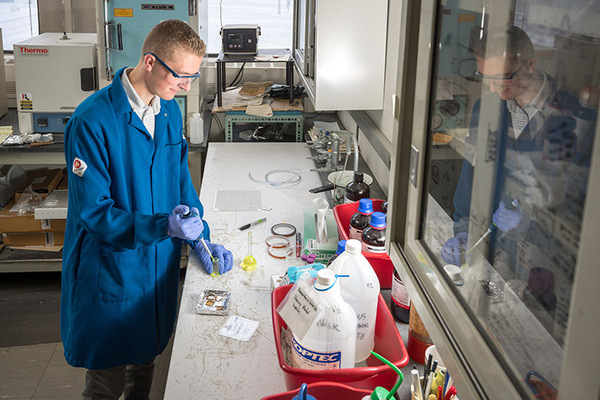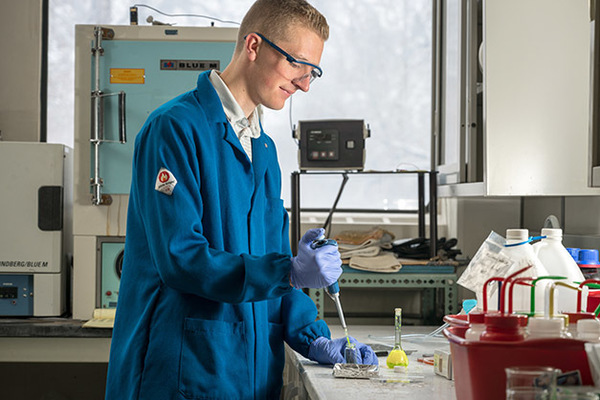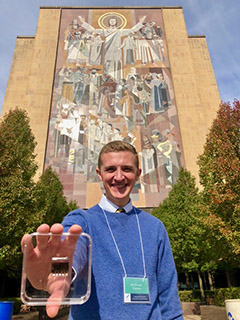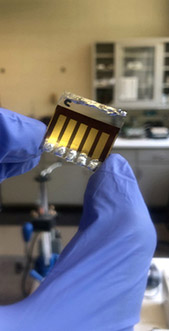

Jake Drysdale has had an interest in sustainability since his first science project in fourth grade, and this passion for protecting the planet has brought him to Notre Dame, Nepal, and back to campus again.
As a child, the chemistry major from St. Louis, Missouri hiked in Montana’s Glacier National Park every summer. During that first research project, he discovered — to his alarm — that its famous glaciers could disappear by 2030.
“That made me concerned about the challenge of climate change but also motivated to find a way to address that,” Drysdale said.
Last summer, Drysdale put his passion for protecting the planet into practice by spending a month before his senior year in Kathmandu, working with the Nepal-based company Gham Power to bring solar-powered water pumps to small farmers. He then returned to Notre Dame to study perovskite solar cells in the lab of Prashant V. Kamat, Rev. John A. Zahm Professor of Science in the Department of Chemistry and Biochemistry.
But Drysdale could not get his time in Nepal off his mind. Partly using his earnings from the Kamat lab, he co-founded his own company, YeTI Photovoltaic, with his father, which helps farmers obtain Gham Power’s water pumps. Through his environmental efforts on and off campus, Drysdale is fostering more sustainable energy and productive agriculture, one solar panel at a time.
Notre Dame has always been a part of Drysdale’s family traditions: his parents met here, he was baptized in the log chapel on campus, and he has family in South Bend. However, the opportunities the College of Science offers for undergraduates to participate in research on the world’s most pressing issues truly interested him in Notre Dame. When he applied to colleges, he looked into labs at the University and was immediately excited by Kamat’s study of energy.
“[Prof. Kamat’s] willingness to allow me to join the lab and to do meaningful research…was really the reason I came to Notre Dame,” Drysdale said. “I had the opportunity to then actually be accepted into the lab and to do research as an undergraduate. It was really a dream come true for me.”

Drysdale shows off a solar cell he made

A perovskite solar cell
Drysdale started working with Kamat during his sophomore year. His research focuses on increasing the effectiveness of perovskite solar cells. Perovskites are an efficient new class of semiconductor which can absorb large amounts of light. This material “has great potential to dramatically lower the cost of solar power while also maintaining high efficiency,” Drysdale explained, because it is cheaper and less energy-intensive to produce than traditional crystalline silicon solar panels. However, perovskite is particularly unstable, lasting at most a year before it breaks down, compared to the 25-year lifespan for silicon cells. By altering the compound’s structure into a more stable state, Drysdale hopes to turn it into an economically viable energy source.
This summer, Drysdale investigated how changing perovskite composition and temperature affects its light-absorption properties and solar cell performance. Yet Drysdale’s favorite part of his research was not just studying the material but using perovskite to make lab-scale solar cells.
“It was something that I’d hoped for but didn’t necessarily expect that I’d have the opportunity to do,” Drysdale explained. Most undergraduates do not have the time to undertake such a technical process, so Drysdale’s summer project was incredibly exciting for the chemistry enthusiast.
In addition to gaining priceless research experience from the lab, Drysdale used some of the money he has earned from his work for Kamat over the past few years to make solar power possible for people who cannot afford this life-changing technology.
Before he returned to Notre Dame this summer, Drysdale received an offer from Tom Purekal at the Pulte Institute for Global Development to work with a startup called Gham Power in Nepal. He volunteered with Brendan Woods, another Notre Dame student, as an in-house consultant for the company’s energy and technical projects. Gham Power sells solar-powered water pumps to micro-farmers in Nepal, and the groundwater collected by the pumps allows families to irrigate their crops more frequently, which supplements unreliable seasonal monsoon rains. This extra irrigation doubles or triples crop yields and corresponds with a similar increase in income, but unfortunately, few farmers in Nepal can afford the initial payment for the technology.
As a small business, Gham Power cannot assume the risk of providing pumps that are not fully financed up front. But in the face of this obstacle, Drysdale saw an opportunity. The company he co-founded, YeTI Photovoltaic, invests in Nepali farmers to bring them this technology faster. The firm established and manages a seed fund which pays Gham Power for the pumps in one lump sum, and then small farmers reimburse YeTI Photovoltaic’s Solar Water Pump Fund in monthly installments. Drysdale’s company started by financing four solar-powered water pumps across Nepal, and each time a farmer makes his or her monthly payment, YeTI Photovoltaic can put that money towards a new pump for another person. Drysdale hopes that the growing, continuous, and self-sustaining fund will help Gham Power fulfill their goal of reaching ten thousand Nepali micro-farmers, and he feels excited about the positive change his company can create.
“Because I can’t always be in Kathmandu, I thought this was also a great way to continue to work with Gham Power and continue to make a difference in Nepal,” Drysdale explained. Solar-powered water pumps allow farmers to earn “income that they would not have otherwise ever expected. And so, in some cases it allows people to send their kids to school, or just [afford] the most basic things that we don’t really think about… It allows people to positively, really transform their lives.”

Drysdale in Nepal
And while Gham Power uses traditional silicon solar cells, Drysdale sees a connection between his perovskite research at Notre Dame and his work in Nepal.
“Even though they’re not using perovskite panels right now for solar water pumps, that is a motivation for me, and more tangible than ever now having been able to actually be in Nepal and understand the reality of the situation and [what] nanotechnology can do to change the situation,” Drysdale said.
If chemistry researchers like Drysdale can fix the stability problems in the compound, while maintaining its high efficiency and low cost, perovskite solar cells can “fulfill their promise” of providing an affordable and sustainable energy solution in places like Nepal, where the biggest percentage of the cost of a water pump comes from its materials. So in addition to his efforts with YeTI Photovoltaic, Drysdale’s work with Kamat also contributes to the goal he has pursued since fourth grade of improving both the environment and human quality of life.
“Nepal is basically an application of solar technology in the world, and then in the lab what I continue to do is help to innovate and advance those technologies so that we can make them better and cheaper,” Drysdale said. “Then we can help people not just in Nepal but all around the world and also…combat climate change.”
Originally published by at science.nd.edu on February 11, 2020.